We live in an age in which we’re used to edited imagery and special effects. But such visual trickery predates Photoshop and other software by a good century and a half. The field of spirit photography relied on a mixture of belief, photographic gimmicks, and new technology to ‘capture’ the dead.
Is it really all just a huge con? Or is there any chance that spirit photography might capture the supernatural?
What is spirit photography?
Spirit photography is essentially the practice of capturing the supernatural. It differs from Victorian death photography since post-mortem photos were portraits of the deceased. But spirit photography was allegedly portraits including their ghosts.
The growth of interest in photography as an artistic medium really exploded in the 1850s and 60s. That’s when photographers discovered techniques like double exposure.
It wasn’t long before less ethical photographers discovered these techniques. They realised they could use these technology to turn a very different kind of profit.
The American photographer William Mumler is considered the first ‘spirit photographer’. He allegedly captured the ghost of his cousin in the early 1860s. In the aftermath of the American Civil War, grieving relatives sought his services to contact their loved ones.
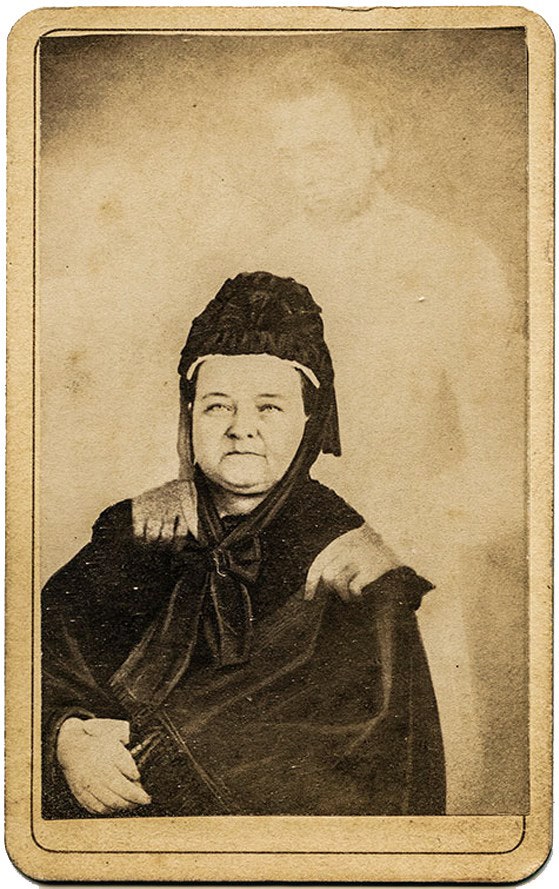
Not everyone sang his praises. Allegations emerged that Mumler stole photos of deceased relatives to insert into his own images. Not only that, some of the ‘spirits’ were actually still alive!
The practice moves to the UK
An English priest, William Stainton Moses, set himself up as an investigator into spirit images. Alan Murdie, chairman of the Ghost Club, explained that Moses believed that there may be a few genuine examples. But there were also people who “would recognise a sheet and a broom as their dear departed” (BBC, 2015).
Such people became the prey of these photographers. One of the more famous practitioners was the “medium”, William Hope. He didn’t become interested in the practice until 1905. Allegedly capturing a ghost while photographing a friend sparked his interest. See below. Um..yeah. Right.
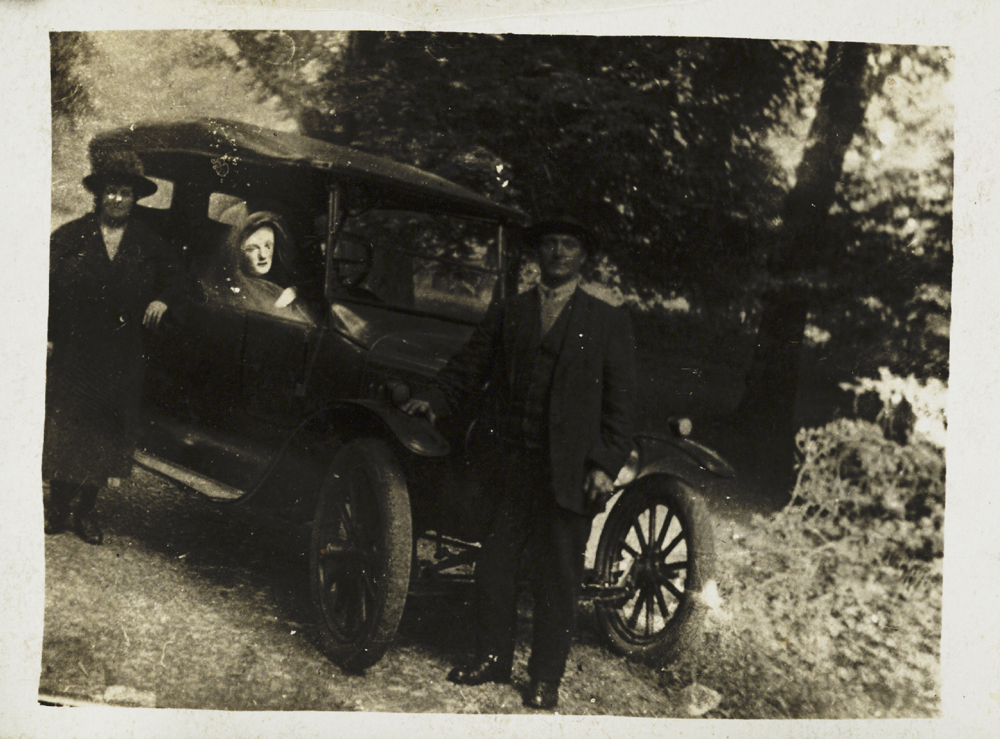
Hope founded the Crewe Circle with five other spirit photographers. The group found themselves in great demand after the First World War. As Mumler found after the American Civil War, relatives wanted to contact their lost loved ones. In their grief, they believed that Hope could help them to do so.
He moved to London in 1922 to set up as a professional medium. The Society for Psychical Research sent Harry Price to investigate him that same year. Price produced evidence that showed Hope produced his photographs using substituted glass plates. The Public Domain Review have an excellent collection of Hope’s images online. Price exposed Hope as a fraudster.
Strangely, some of Hope’s supporters continued to campaign for his innocence. Sir Arthur Conan Doyle counted among these supporters. He supplied the below image as evidence. Ada Deane, an apparent spirit photographer, took it in early 1922.
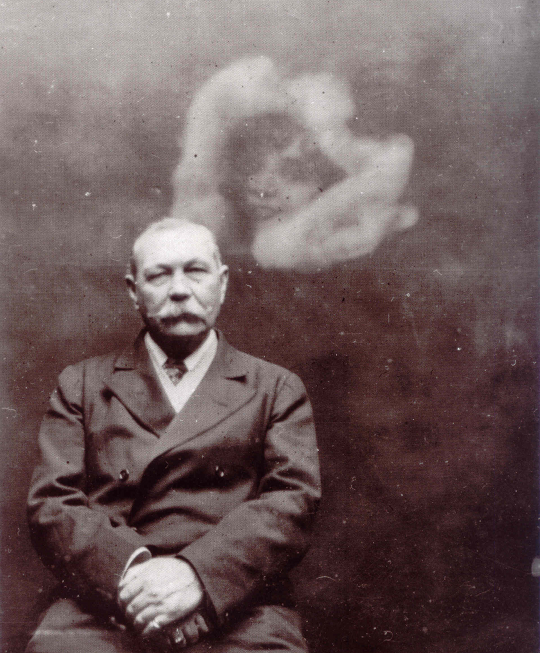
Remember Sir Arthur Conan Doyle also believed the Cottingley fairies photos were real. He might have created Sherlock Holmes, but Holmes’ keen eye for detail eluded him!
“Psychic Photography From A New Angle”
Mr C.P. MacCarthy of 15 Wilkinson Street, Sheffield put together a lantern slide talk in 1934. In the process, he created his own psychic photography. But as Tyne & Wear Archives point out, his intention was to “demonstrate under test conditions Fake Psychic Photography”.
He wanted to prove photographers could fake images under test conditions. But he also wanted to show that viewers couldn’t be too critical, while investigating the probability of genuine photography alongside the new opportunities for fraud.
This is his equipment.
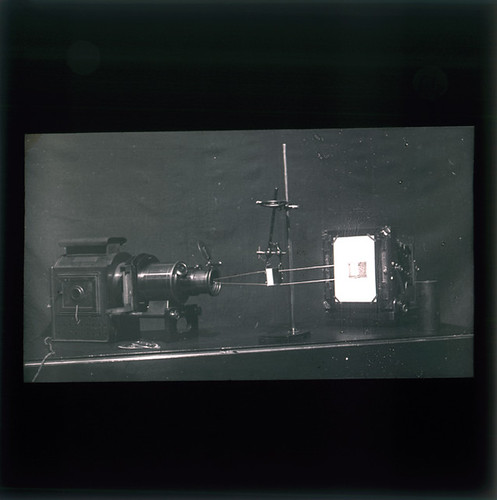
I can’t find any explanation as to how it actually works. But the fact Mr MacCarthy included an image of it in his Psychic Photography talk shows he wanted to be transparent about the process.
(Edit: The very helpful Chris Wood pointed out at the “equipment is just a lantern with a picture on it on the right and angled glass or a prism before the lens.” Sardonicus clarified that the principle was similar to the Pepper’s Ghost illusion within Victorian theatre.)
After all, he included this image and named it ‘A Psychic Apparition’. You don’t have to be Derren Brown to recognise a roll of gauze bandage when you see it.
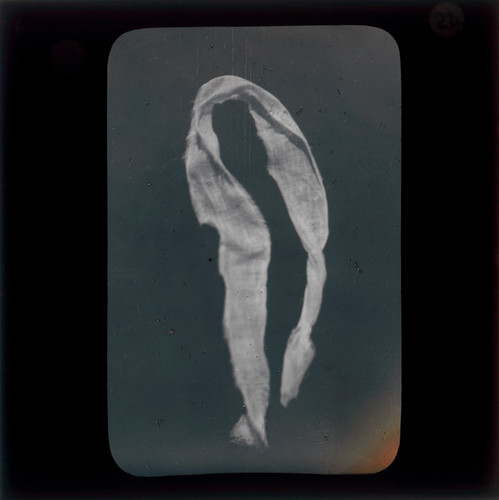
Lots of spirit photographs exist that apparently depict ectoplasm issuing from the bodies of mediums, often from the mouth or ears. There’s also a particularly disturbing aspect of Victorian pornography that pictures ectoplasm issuing from other bodily orifices!
Given scientists have never been able to capture ectoplasm as a substance, is it likely that photographers can catch it on film? Or is it more likely a household object they had lying around?
So it’s fake then?
In all likelihood it is. Just look at the example below, one of Hope’s images. Does this look real to you?

In earlier eras, images could be faked using multiple exposure. Photographers placed two glass plates together and made a new image of both. In the above case, the photographer might have added the image of Mrs Leverson’s husband to a white blob on one plate. Mrs Leverson was photographed on the other. When exposed, the ghostly image suddenly appears behind her.
Nowadays, the use of Photoshop can’t be excluded. But it’s even easier than that to take a ghost photograph. Set your camera on a tripod, and take a long exposure of your scene. Simply walk through quickly. You’ll see a ghostly figure on the resulting photo!

In its defence…
In the interests of fairness, I should probably add that some people do defend spirit photography as a valid paranormal investigation tool. I’m not talking about photos of orbs here. Most times, amateur ghost hunters use the flash to take photos. The light bounces off dust, moisture or insects in the air, showing up as orbs.
But there are examples of spirit photographs that experts find harder to dismiss. Such as the Lord Combermere photo of 1895.

Sybell Corbett took the photograph in December 1891 at Combermere Abbey in Cheshire. The exposure actually took an hour. According to Sybell’s photographic diary, no one entered the room during the exposure. Yet the head, arm and upper body of a man appears in a chair at the lefthand side.
A relative of Lord Combermere declared the figure to be the lord, but there was a problem. Lord Combermere had recently died, and the photo was taken during his funeral.
Sir William Barrett, of the Society of Psychical Research, investigated the case. At first, he thought a servant had just sat down and stood up again during the exposure. Later he discovered all of the servants attended the funeral. None of them resembled the figure.
Spooky!
While many of the images do look incredibly fake, there are still those examples of spirit photography that defy explanation. And it’s those images that keep belief in the practice very much alive…
You can find some awesome examples of spirit photography here!
Taking things literally
Inspired by spirit photography, I wrote the below micro-story in 2015. It’s essentially an ad…
Ladies, are you tired of wispy hair, or ectoplasmic break outs spoiling your best attempts at being captured on film? Do you dread the sight of a camera, and seek to hide in the shadows? There’s no need to be so bashful – our team can primp and preen even across the Veil!
So if you want to appear in family portraits, and enjoy the gaze of the camera even after the final sleep, then come and see Reginald Flow and his amazing make-up assistant, Petronella the Great – we’ll always capture your best side, even though you’re on the Other Side!
If you enjoyed this post, please consider sharing it with like-minded people! And if you want more content like this in audio form, why not become a patron of my podcast and get an exclusive episode about all things occult-y and supernatural every month!
Nutty about folklore and want more?
Add your email below and get these posts in your inbox every week.
You'll also get my 5-step guide to protecting your home using folklore!








So interesting. I’d never looked deeply into the process. Some photos are obviously easier to dismiss than others but, as a whole, I feel like I can’t dismiss everything outright. Though the photo you took is awesome. Get down with your spooky self.
Are you writing a post about the (creepy) practice of taking “family” photos with the recently dead body of a family member? Post-mortem photography was really popular in the Victorian era.
Ooh I could do. I wrote about that for my PhD so I’d be happy to put something up on here!
ahh man, I was hoping this would have been a ‘here are all the photos that appear to be real’ post rather than the other way round. I love a good mystery!! :p awesome post. Helen wrote one recently on orbs in photos. Wish I could capture something like this.
Trying to get permission for a lot of them is a bugger! I’m totally skeptical about spirit photographs after all the ghost hunts I’ve done, but I’ll see what I can find for a potential Part 2!